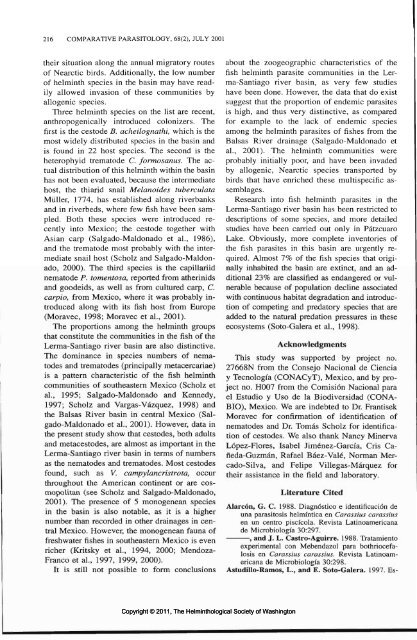Comparative Parasitology 68(2) 2001 - Peru State College
Comparative Parasitology 68(2) 2001 - Peru State College
Comparative Parasitology 68(2) 2001 - Peru State College
You also want an ePaper? Increase the reach of your titles
YUMPU automatically turns print PDFs into web optimized ePapers that Google loves.
216 COMPARATIVE PARASITOLOGY, <strong>68</strong>(2), JULY <strong>2001</strong><br />
their situation along the annual migratory routes<br />
of Nearctic birds. Additionally, the low number<br />
of helminth species in the basin may have readily<br />
allowed invasion of these communities by<br />
allogenic species.<br />
Three helminth species on the list are recent,<br />
anthropogenically introduced colonizers. The<br />
first is the cestode B. acheilognathi, which is the<br />
most widely distributed species in the basin and<br />
is found in 22 host species. The second is the<br />
heterophyid trematode C. formosanus. The actual<br />
distribution of this helminth within the basin<br />
has not been evaluated, because the intermediate<br />
host, the thiarid snail Melanoides tuberculata<br />
Miiller, 1774, has established along riverbanks<br />
and in riverbeds, where few fish have been sampled.<br />
Both these species were introduced recently<br />
into Mexico; the cestode together with<br />
Asian carp (Salgado-Maldonado et al., 1986),<br />
and the trematode most probably with the intermediate<br />
snail host (Scholz and Salgado-Maldonado,<br />
2000). The third species is the capillariid<br />
nematode P. tomentosa, reported from atherinids<br />
and goodeids, as well as from cultured carp, C.<br />
carpio, from Mexico, where it was probably introduced<br />
along with its fish host from Europe<br />
(Moravec, 1998; Moravec et al., <strong>2001</strong>).<br />
The proportions among the helminth groups<br />
that constitute the communities in the fish of the<br />
Lerma-Santiago river basin are also distinctive.<br />
The dominance in species numbers of nematodes<br />
and trematodes (principally metacercariae)<br />
is a pattern characteristic of the fish helminth<br />
communities of southeastern Mexico (Scholz et<br />
al., 1995; Salgado-Maldonado and Kennedy,<br />
1997; Scholz and Vargas-Vazquez, 1998) and<br />
the Balsas River basin in central Mexico (Salgado-Maldonado<br />
et al., <strong>2001</strong>). However, data in<br />
the present study show that cestodes, both adults<br />
and metacestodes, are almost as important in the<br />
Lerma-Santiago river basin in terms of numbers<br />
as the nematodes and trematodes. Most cestodes<br />
found, such as V. campylancristrota, occur<br />
throughout the American continent or are cosmopolitan<br />
(see Scholz and Salgado-Maldonado,<br />
<strong>2001</strong>). The presence of 5 monogenean species<br />
in the basin is also notable, as it is a higher<br />
number than recorded in other drainages in central<br />
Mexico. However, the monogenean fauna of<br />
freshwater fishes in southeastern Mexico is even<br />
richer (Kritsky et al., 1994, 2000; Mendoza-<br />
Franco et al., 1997, 1999, 2000).<br />
It is still not possible to form conclusions<br />
Copyright © 2011, The Helminthological Society of Washington<br />
about the zoogeographic characteristics of the<br />
fish helminth parasite communities in the Lerma-Santiago<br />
river basin, as very few studies<br />
have been done. However, the data that do exist<br />
suggest that the proportion of endemic parasites<br />
is high, and thus very distinctive, as compared<br />
for example to the lack of endemic species<br />
among the helminth parasites of fishes from the<br />
Balsas River drainage (Salgado-Maldonado et<br />
al., <strong>2001</strong>). The helminth communities were<br />
probably initially poor, and have been invaded<br />
by allogenic, Nearctic species transported by<br />
birds that have enriched these multispecific assemblages.<br />
Research into fish helminth parasites in the<br />
Lerma-Santiago river basin has been restricted to<br />
descriptions of some species, and more detailed<br />
studies have been carried out only in Patzcuaro<br />
Lake. Obviously, more complete inventories of<br />
the fish parasites in this basin are urgently required.<br />
Almost 7% of the fish species that originally<br />
inhabited the basin are extinct, and an additional<br />
23% are classified as endangered or vulnerable<br />
because of population decline associated<br />
with continuous habitat degradation and introduction<br />
of competing and predatory species that are<br />
added to the natural predation pressures in these<br />
ecosystems (Soto-Galera et al., 1998).<br />
Acknowledgments<br />
This study was supported by project no.<br />
276<strong>68</strong>N from the Consejo Nacional de Ciencia<br />
y Tecnologia (CONACyT), Mexico, and by project<br />
no. H007 from the Comision Nacional para<br />
el Estudio y Uso de la Biodiversidad (CONA-<br />
BIO), Mexico. We are indebted to Dr. Frantisek<br />
Moravec for confirmation of identification of<br />
nematodes and Dr. Tomas Scholz for identification<br />
of cestodes. We also thank Nancy Minerva<br />
Lopez-Flores, Isabel Jimenez-Garcia, Cris Caneda-Guzman,<br />
Rafael Baez-Vale, Norman Mercado-Silva,<br />
and Felipe Villegas-Marquez for<br />
their assistance in the field and laboratory.<br />
Literature Cited<br />
Alarcon, G. C. 1988. Diagnostico e identificacion de<br />
una parasitosis helmmtica en Carassius carassius<br />
en un centre piscicola. Revista Latinoamericana<br />
de Microbiologia 30:297.<br />
, and J. L. Castro-Aguirre. 1988. Tratamiento<br />
experimental con Mebendazol para bothriocefalosis<br />
en Carassius carassius. Revista Latinoamericana<br />
de Microbiologfa 30:298.<br />
Astudillo-Ramos, L., and E. Soto-Galera. 1997. Es-
















